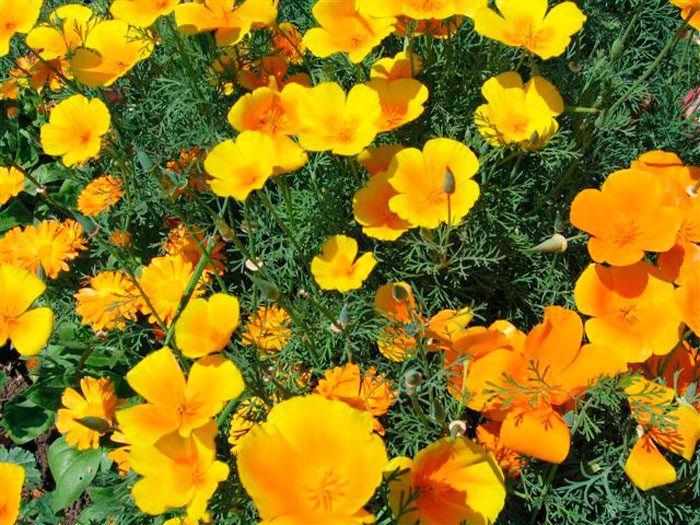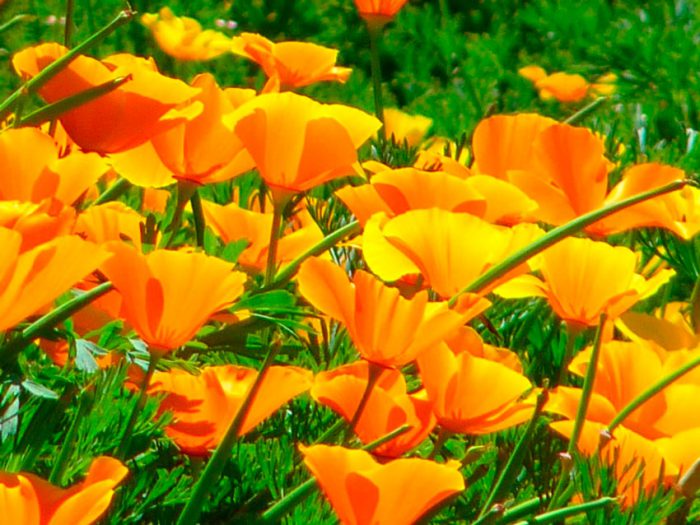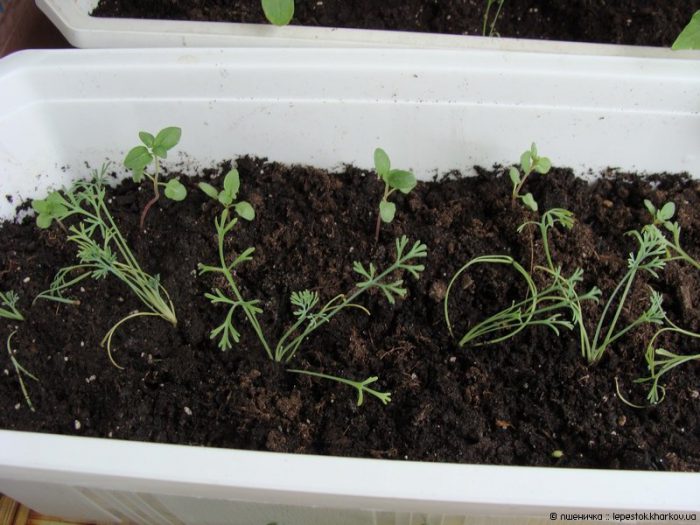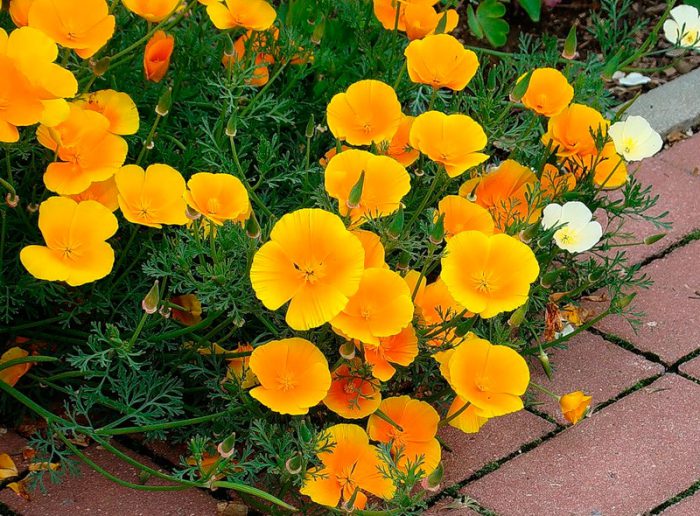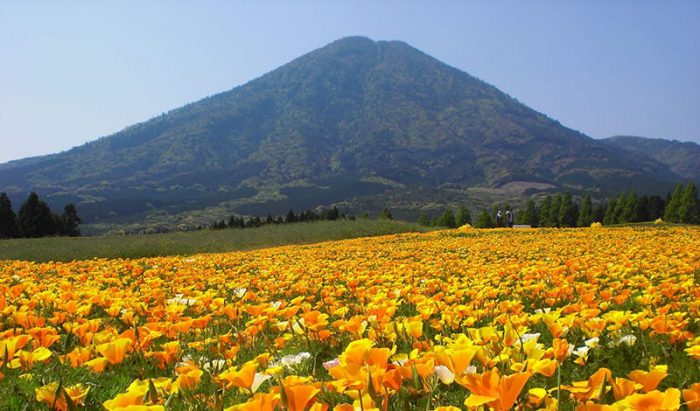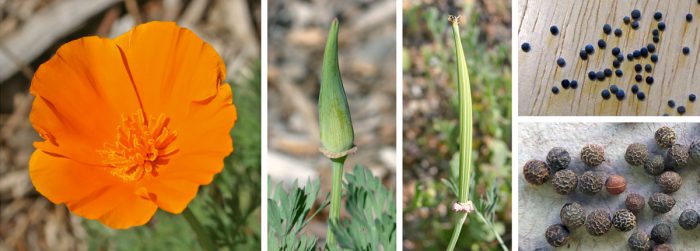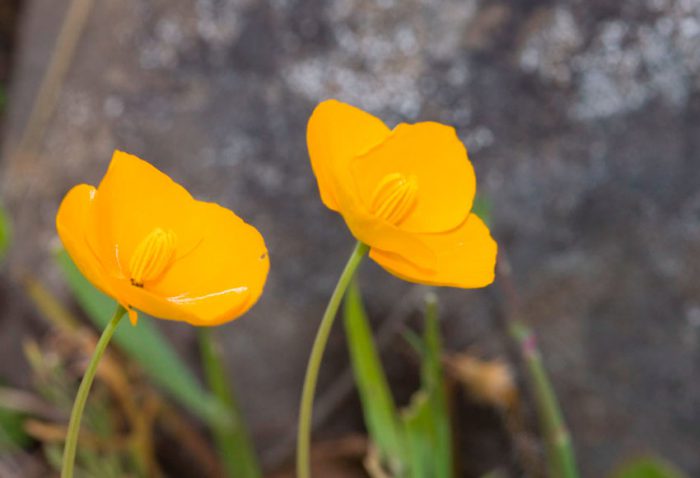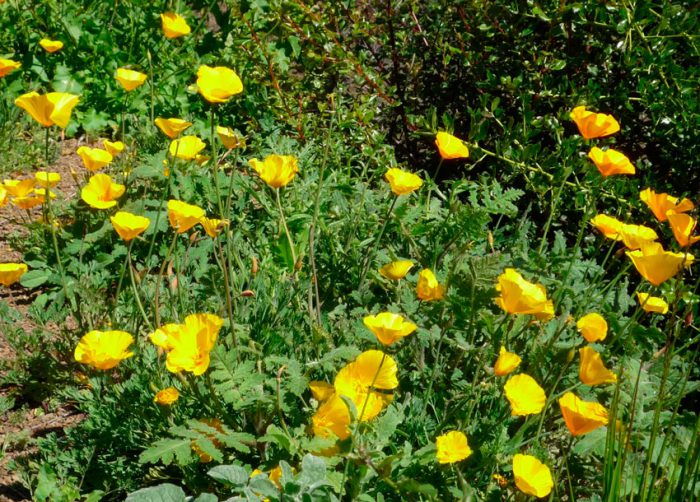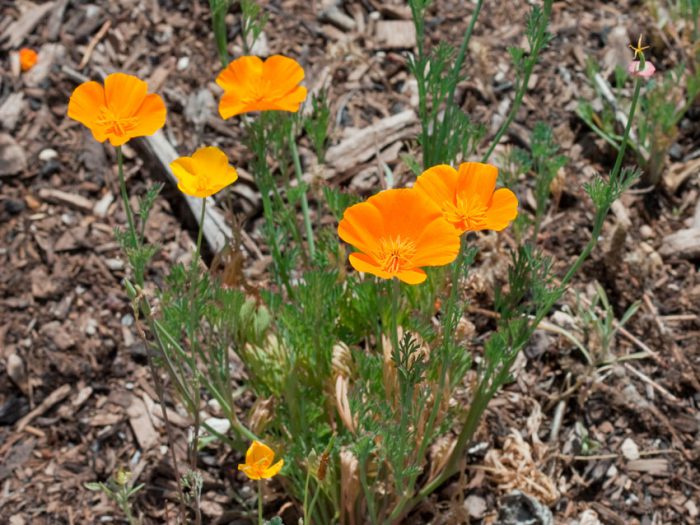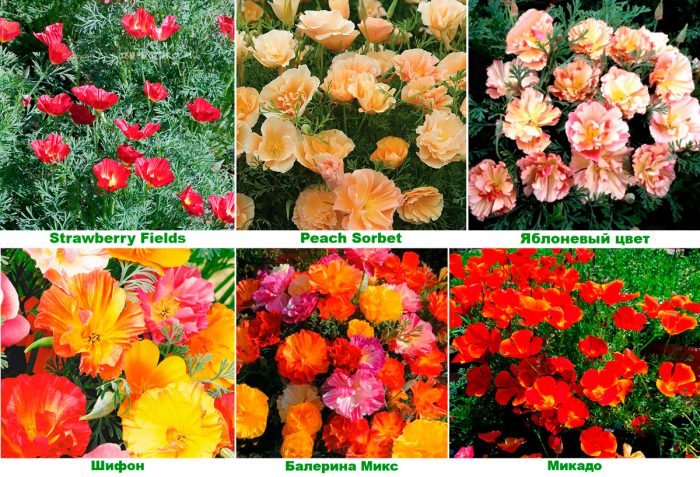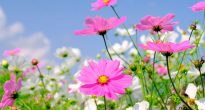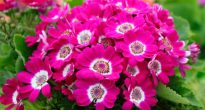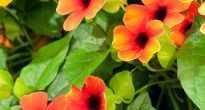Eschscholzia, also called the Californian poppy, is a member of the poppy family. This genus includes about 10 species. In the wild, this plant can be found in western North America. There is one old legend, in the 16th century. gold diggers from Spain swam to the coast of America in the hope of finding gold mines. Before reaching 35 miles to the coast, they saw a golden glow and rushed to the coast of California, hoping that it glitters gold. But they were disappointed, because it was the golden fields of the escholzia. Since then, this plant has a new playful name given to it by the Spaniards, "Copa de Ora", which translates as "golden bowl". This flower was named after the Russian zoologist, botanist, naturalist and physician Johann Friedrich von Eschsholz, thanks to whom he ended up in Russia. Eschsholzia is incredibly beautiful and, moreover, is distinguished by its unpretentiousness, which is why an increasing number of gardeners grow it every year. Her flowering is very lush and long, it begins in the first summer days, and ends almost at the beginning of winter. Despite the fact that the opened flower withers after only 3-4 days, it is immediately replaced by several buds and flowers.
Content
Escholzia features
Escholzia is a herbaceous bushy perennial plant, the height of which can reach up to 0.4 m. It is cultivated as an annual flower. Taproot. There are a large number of thin stems. Openwork leaf plates are deeply dissected, they are colored green-gray and have long petioles. Single cupped flowers reach 8 centimeters in diameter. Flowers can be double or simple, while outwardly they are similar to poppies. Their color can be yellow, red, white, orange, and they are also painted in various shades of these colors. Such flowers have one feature, the fact is that on a cloudy, rainy, windy or cold day, as well as at night, they close. The fruit is a capsule, the size of which varies from 3 to 9 centimeters.
Growing escholzia from seeds
Sowing
Often, seeds are sown directly into open soil. Experienced gardeners recommend sowing escholzia before winter. The fact is that in the winter months the seeds will be able to undergo natural stratification, and powerful seedlings will appear in the spring, they will only need to be thinned out. It should also be taken into account that in plants sown in autumn, flowering begins earlier than in those whose sowing was carried out in the spring. In the event that you decide to sow in spring, in the fall the seeds must be placed on the lowest shelf of the refrigerator, where they will stay until April. Thus, they will be stratified and perfectly preserved.
For sowing, choose a well-lit area with sandy dry soil. Then it is necessary to make not very deep grooves in it, into which small seeds are sown, previously combined with sand. They should be shallowly embedded, and then the surface of the site is covered with a layer of peat, this will help to avoid the appearance of a crust on the soil surface, which will become a serious obstacle for delicate sprouts. If the sowing is done in the fall, then the area must be covered with fallen leaves, and the layer must be thick enough.
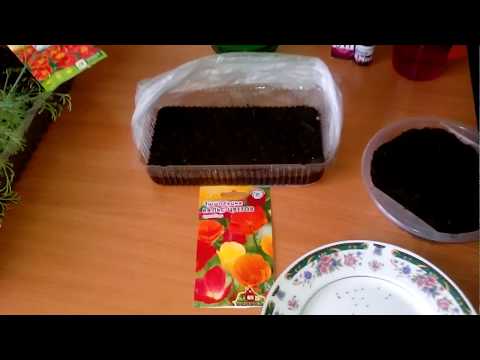

Watch this video on YouTube
Seedling
Experienced gardeners recommend resorting to growing escholzia through seedlings. With this method of growing this plant, it should be remembered that it has a rod-like long root system, which is extremely easy to injure during a dive, in this regard, it is recommended to use peat tablets for sowing. To do this, the tablets must be placed in a plastic container into which water is poured. After the tablets have swollen, the remaining liquid must be poured out of the container. In 1 tablet, only 1 seed should be sown, using a wet toothpick for this. From above, the seeds are sprinkled with a thin layer of soil for seedlings. The tablets only need to be slightly moistened from the spray bottle. The container should be covered with a transparent film or glass on top. The first seedlings can be seen after half a month, after which the shelter is removed, and the container itself is placed in a well-lit and cool (no more than 20 degrees) place. It is very simple to take care of seedlings at this time: they need to be watered in a timely manner and fed with liquid mineral fertilizer for seedlings half a month after the plants have sprout. Hardening of seedlings should be started 20 days before transplanting into open soil; for this, it is transferred once a day to a cool room, where it must stay for several hours. If the escholzia is hardened, then after landing in the garden, it will be able to calmly endure a decrease in air temperature to minus 5 degrees.
Planting an escholzia in open ground
What time to plant
For planting escholzia, you should choose an area with sandy dry soil that is well-drained, which should be slightly acidic or neutral. In the event that the soil is sour, then this can be corrected by digging it to the depth of the shovel bayonet and at the same time adding 2 tbsp. wood ash or 0.2 kg of dolomite flour per 1 m2... Seedlings should be planted after the threat of return frosts has completely passed, depending on the region, it is carried out from April to mid-May.
Landing features
To begin with, not very large planting holes should be prepared on the site, while the distance between them should be about 0.3 m, since the Escholzia bushes are quite spreading. The plant should be immersed in the hole along with a peat tablet, then it is covered with soil, which is well compacted. The planted plants need to be watered. The flowering of such an escholzia is observed already 30–40 days after its sowing on seedlings.
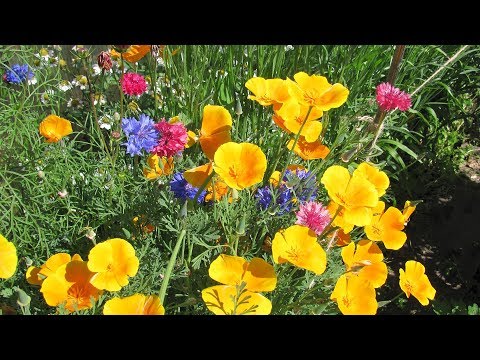

Watch this video on YouTube
Care features
After the escholzia is planted in open soil, it will need to ensure systematic loosening of the soil surface, and it also needs to be fertilized on time. Watering should only be done when there is an extended dry period. If it rains systematically in the summer, then these flowers will not need watering. If you want Echscholzia to bloom for a very long time and magnificently, then before the beginning of the flowering period it should be fed with a complete mineral fertilizer, which must necessarily include phosphorus, potassium, nitrogen and trace elements, or you can use an ash infusion in a ratio of 1:10. Do not feed these flowers with fresh organic matter, as this can lead to their death. It should be remembered that escholzia reproduces well by self-seeding, if this is not included in your plans, then you just need to remove flowers that have begun to fade in a timely manner. When the bush has completely bloomed, you need to cut off all its old stems, and after a short period of time, young ones will appear in their place, which will begin to bloom in just 15-20 days.
Diseases and pests
Remember, that you do not have any problems with growing this plant, you need to properly care for it, as well as provide suitable conditions for its growth. For example, if you violate the rules of agricultural technology and care, then leguminous aphids can settle on the bushes. To get rid of it, it is necessary to process the affected specimens by the Commander. If the summer period is very hot and dry, then spider mites can settle on Escholzia. To get rid of these pests, use the Actellik insecticide. If the plant is watered very abundantly, rot may appear on its roots and ground parts. In this case, it is necessary to sharply reduce watering and cut out all the affected areas. In the event that the flower is very rotten, then it will be necessary to dig up and destroy the entire bush. If the plant becomes infected with powdery mildew, then it must be treated with sulfur.
Escholzia properties
For a long time, the aerial parts of such a plant were used by the American Indians as an analgesic for toothaches, while the pollen collected from its flowers was an excellent cosmetic product. A decoction was made from the flowers of the escholzia, which perfectly helped with head lice. Today, in the United States, preparations from such a plant are used in pediatrics as a sedative and analgesic agent, while in France it is grown on an industrial scale and used as a raw material for the pharmaceutical industry. These medicines have one tangible advantage - the absence of unwanted side effects, which is very rare for benzodiazepine drugs.
Escholzia after flowering
Seed collection
In the event that you decide to collect the seeds of Escholzia in order to sow them in autumn or spring, then you do not need to do this, since these flowers reproduce very well by self-seeding. All that needs to be done is to thin out the seedlings in the spring and wait for lush flowering. Seeds are necessary if you are just starting to breed such a beautiful plant or decide to give them to someone. To prevent the seeds from spilling out on the ground, bags made of gauze should be put on several wilting flowers. Then you need to wait about 4 weeks, since the seeds should ripen well. Then the boxes are cut off and seeds are extracted from them on a newspaper leaf at home. They should be thoroughly dried and placed in a paper bag, which is placed on the bottom shelf of the refrigerator, where the seeds will be stored until spring. If done correctly, the seeds will remain viable for three years.
Preparing for winter
Despite the fact that there are perennial species of escholzia, in the middle latitudes, these flowers are cultivated only as an annual or biennial.In this regard, in the autumn, it will be necessary to cut off the remnants of plants and dig up the site. In spring, strong seedlings will definitely appear on the site. They should be thinned out and fed, and after 4 weeks such plants will please you again with their spectacular and lush flowering.
Types and varieties of escholzia with photos and names
Gardeners of middle latitudes cultivate, as a rule, only Aescholzia turfy, Californian, and quite rarely Aescholzia lobbies.
Eschscholzia lobbi
The bush reaches a height of no more than 15 centimeters. The diameter of pale yellow flowers reaches 20 mm.
Sod Eshscholzia (Eschscholzia caespitosa)
The height of this species also does not exceed 15 centimeters. The leaf rosette consists of thin leaf plates, three times dissected, on their surface there is a coating of wax, and they are painted in a greenish-gray color. Above the rosette, there is a dense inflorescence of deep yellow cupped flowers, the diameter of which is approximately 30 mm. Flowering begins in June and ends before the onset of winter.
Californian Eschscholzia (Eschscholzia californica)
This species is outwardly similar to the wild poppy, and it is then called "Californian poppy". This creeping, branched herbaceous shrub is a perennial, its height does not exceed 0.4 m. It has a large number of thin greenish-gray ribbed shoots that are located on the stem. They are covered with light-gray, triple dissected leaf plates. The diameter of single cupped flowers is about 9 centimeters, they can be painted in white, orange, yellow, cream or carmine color. Flowering is very lush, it is observed from June until the first frost. Most popular varieties:
- Strawberry fields... The flowers are painted at the edges in a deep red color, which changes to yellow in the middle.
- Peach sorbet... Terry delicate flowers have a cream color.
- Simple flowers are dark carmine in color.
- Apple blossom... Sufficiently large double flowers have a color similar to apple blossom.
- Chiffon... This is a mixture of seeds, which includes plants of various colors and sizes, they are recommended for decorating borders or lawns. The height of the bushes can vary from 0.35 to 0.4 m. Terry flowers have corrugated edges. They can be painted in deep pink, red, yellow or white, while several shades are combined in one flower. Flowering begins in May and ends with the onset of frost.
- Ballerina Mix... This mixture consists of simple and terry varieties. The flower color can be yellow, orange or pink. Their diameter is 5–8 centimeters. The height of the bushes varies from 0.25 to 0.4 m. There is a coating of wax on the surface of the three times dissected leaf plates.
- Mikado... The height of the bush varies from 0.3 to 0.4 m. The diameter of simple flowers is 6-7 centimeters. Their color is deep yellow, with a large orange spot in the middle.
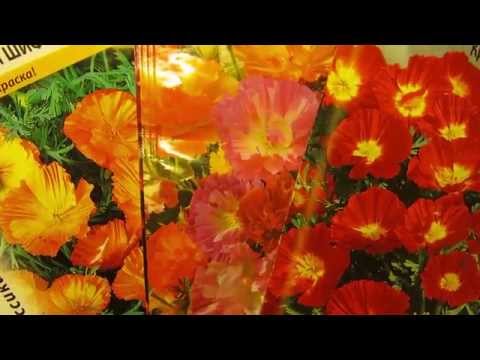

Watch this video on YouTube

